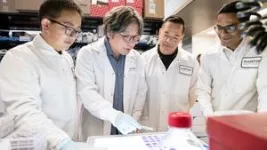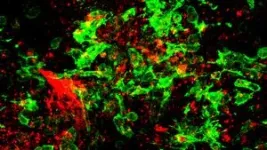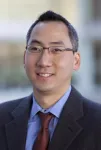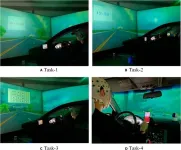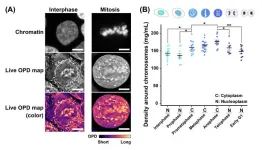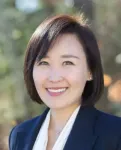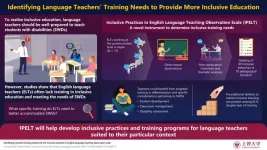(Press-News.org) CHAMPAIGN, Ill. — Artificial intelligence is a powerful tool for researchers, but with a significant limitation: The inability to explain how it came to its decisions, a problem known as the “AI black box.” By combining AI with automated chemical synthesis and experimental validation, an interdisciplinary team of researchers at the University of Illinois Urbana-Champaign has opened up the black box to find the chemical principles that AI relied on to improve molecules for harvesting solar energy.
The result produced light-harvesting molecules four times more stable than the starting point, as well as crucial new insights into what makes them stable — a chemical question that has stymied materials development.
The interdisciplinary team of researchers was co-led by U. of I. chemistry professor Martin Burke, chemical and biomolecular engineering professor Ying Diao, chemistry professor Nicholas Jackson and materials science and engineering professor Charles Schroeder, in collaboration with along with University of Toronto chemistry professor Alán Aspuru-Guzik. They published their results in the journal Nature.
“New AI tools have incredible power. But if you try to open the hood and understand what they’re doing, you’re usually left with nothing of use,” Jackson said. “For chemistry, this can be very frustrating. AI can help us optimize a molecule, but it can’t tell us why that’s the optimum — what are the important properties, structures and functions? Through our process, we identified what gives these molecules greater photostability. We turned the AI black box into a transparent glass globe.”
The researchers were motivated by the question of how to improve organic solar cells, which are based on thin, flexible materials, as opposed to the rigid, heavy, silicon-based panels that now dot rooftops and fields.
“What has been hindering commercialization of organic photovoltaics is problems with stability. High-performance materials degrade when exposed to light, which is not what you want in a solar cell,” said Diao. “They can be made and installed in ways not possible with silicon and can convert heat and infrared light to energy as well, but the stability has been a problem since the 1980s.”
The Illinois method, called “closed-loop transfer,” begins with an AI-guided optimization protocol called closed-loop experimentation. The researchers asked the AI to optimize the photostability of light-harvesting molecules, Schroeder said. The AI algorithm provided suggestions about what kinds of chemicals to synthesize and explore in multiple rounds of closed-loop synthesis and experimental characterization. After each round, the new data were incorporated back into the model, which then provided improved suggestions, with each round moving closer to the desired outcome.
The researchers produced 30 new chemical candidates over five rounds of closed-loop experimentation, thanks to building block-like chemistry and automated synthesis pioneered by Burke’s group. The work was done at the Molecule Maker Lab housed in the Beckman Institute for Advanced Science and Technology at the U. of I.
“The modular chemistry approach beautifully complements the closed-loop experiment. The AI algorithm requests new data with maximized learning potential, and the automated molecule synthesis platform can generate the new required compounds very quickly. Those compounds are then tested, the data goes back into the model, and the model gets smarter — again and again,” said Burke, who also is a professor in the Carle Illinois College of Medicine. “Until now, we’ve been largely focused on structure. Our automated modular synthesis now has graduated to the realm of exploring function.”
Instead of simply ending the query with the final products singled out by the AI, as in a typical AI-led campaign, the closed-loop transfer process further sought to uncover the hidden rules that made the new molecules more stable.
As the closed-loop experiment ran, another set of algorithms was continuously looking at the molecules made, developing models of chemical features predictive of stability in light, Jackson said. Once the experiment concluded, the models provided new lab-testable hypotheses.
“We're using AI to generate hypotheses that we can validate to then spark new human-driven campaigns of discovery,” Jackson said. “Now that we have some physical descriptors of what makes molecules photostable, that makes the screening process for new chemical candidates dramatically simpler than blindly searching around chemical space.”
To test their hypothesis about photostability, the researchers investigated three structurally different light-harvesting molecules with the chemical property they identified — a particular high-energy region — and confirmed that choosing the proper solvents made the molecules up to four times more light-stable.
“This is a proof of principle for what can be done. We’re confident we can address other material systems, and the possibilities are only limited by our imagination. Eventually, we envision an interface where researchers can input a chemical function they want and the AI will generate hypotheses to test,” Schroeder said. “This work could only happen with a multidisciplinary team, and the people, resources and facilities we have at Illinois, and our collaborator in Toronto. Five groups came together to generate new scientific insight that would not have been possible with any one of the sub teams working in isolation.”
This work was supported by the Molecule Maker Lab Institute, an AI Research Institutes program supported by the U.S. National Science Foundation under grant no. 2019897 .
Editor’s note:
To reach Nick Jackson, email jacksonn@illinois.edu. To reach Martin Burke, email mdburke@illinois.edu.
The paper, “Closed-loop transfer enables AI to yield chemical knowledge,” is available online.
DOI: 10.1038/s41586-024-07892-1
END
Breaking open the AI black box, team finds key chemistry for solar energy and beyond
2024-08-28
ELSE PRESS RELEASES FROM THIS DATE:
Discovery of how blood clots harm brain and body in COVID-19 points to new therapy
2024-08-28
In a study that reshapes what we know about COVID-19 and its most perplexing symptoms, scientists have discovered that the blood coagulation protein fibrin causes the unusual clotting and inflammation that have become hallmarks of the disease, while also suppressing the body’s ability to clear the virus.
Importantly, the team also identified a new antibody therapy to combat all of these deleterious effects.
Published in Nature, the study by Gladstone Institutes and collaborators overturns the prevailing ...
JAMA review highlights advances in kidney cancer research and care
2024-08-28
CHAPEL HILL, North Carolina — New insights into the biology of kidney cancer, including those informed by scientific discoveries that earned a Nobel Prize, have led to advances in treatment and increased survival rates, according to a review by UNC Lineberger Comprehensive Cancer Center’s William Kim, MD, and Tracy Rose, MD, MPH.
Their observations, drawn from a meta-analysis of 89 studies published between January 2013 and January 2024, were published in JAMA Aug. 28.
“The Nobel Prize in Medicine or Physiology in 2019 was awarded ...
new diabetes research in Scientific Reports links blood glucose levels and voice
2024-08-28
NEW YORK/TORONTO – August 28, 2024 – As part of its ongoing exploration of vocal biomarkers and the role they can play in enhancing health outcomes, Klick Labs published a new study in Scientific Reports today – confirming the link between blood glucose levels and voice pitch and opening the door to future advancements in non-invasive glucose monitoring for people living with Type 2 diabetes.
In “Linear Effects of Glucose Levels on Voice Fundamental Frequency in Type 2 diabetes and Individuals with Normoglycemia,” researchers ...
Augmented recognition of distracted driving state based on electrophysiological analysis of brain network
2024-08-28
A research paper by scientists at Beijing Jiaotong University proposed an electrophysiological analysis-based brain network method for the augmented recognition of different types of distractions during driving.
The new research paper, published on Jul. 04 in the journal Cyborg and Bionic Systems, designed and conducted a simulated experiment comprising 4 distracted driving subtasks. Three connectivity indices, including both linear and nonlinear synchronization measures, were chosen to construct the brain network. By computing connectivity strengths and topological features, we explored the potential relationship between brain network configurations and states ...
The functions of actin-binding proteins are regulated by the flexibility and specific helical twists of actin filaments
2024-08-28
Researchers at Kanazawa University report in eLife on deciphering the actin structure-dependent preferential cooperative binding of cofilin.
The actin filament is a double-stranded helical structure formed by intertwining two long-pitch helices, with the distance between crossover points, known as the half helical pitch (HHP), being about 36 nm. A canonical half helix consists of 13 actin protomers, or 6.5 protomer pairs, resulting in a mean axial distance (MAD) of 5.5 nm between two adjacent protomers ...
Team discovers transient rise in depletion attraction contributes to mitotic chromosome condensation
2024-08-28
A team of scientists studying cell division developed a special light microscopy system and used it to analyze the molecular density of cellular environments. Their results provide a novel insight into mitotic chromosome condensation in living human cells.
Their work is published in the journal Proceedings of the National Academy of Sciences (PNAS) on August 27, 2024.
DOI:https://doi.org/10.1073/pnas.2403153121
To carry out their study, the team developed an orientation-independent-differential interference contrast (OI-DIC) microscopy system combined with a confocal ...
nTIDE Deeper Dive August 2024: Disability Employment Disparities Among Students: High School Struggles, College Advancement
2024-08-28
East Hanover, NJ – August 28, 2024 – Young people with disabilities aged 16 to 24 had high school enrollment rates nearly identical to their non-disabled peers, but significantly fewer held jobs during this time. Meanwhile, college students with disabilities were less likely to be enrolled but were slightly more likely to be employed, possibly benefiting from the rise of remote work opportunities in the post-COVID era, according to data shared during the according to last Friday’s National Trends in Disability ...
Rain or shine? How rainfall impacts size of sea turtle hatchlings
2024-08-28
Female sea turtles lay their eggs, cover the nest with sand and then return to the ocean, leaving them to develop and hatch on their own. From nest predators to rising temperatures, odds of survival are bleak. Once hatched and in the ocean, about one in 1,000 make it to adulthood.
Hatchling size matters. Larger hatchlings, which move faster, are more likely to survive because they spend less time on risky beach sands.
Research shows that both air and sand temperatures crucially impact sea turtle hatchlings. Cooler temperatures produce larger, heavier hatchlings with more males, while warmer temperatures ...
How breast cancer goes hungry
2024-08-28
Cancer cells have voracious appetites. And there are certain nutrients they can’t live without. Scientists have long hoped they might stop tumors in their tracks by cutting off an essential part of cancer cells’ diet. But these cells are crafty and often find a new way to get what they need. How? By reprogramming their metabolism and switching to backup food supplies.
Now, Cold Spring Harbor Laboratory (CSHL) Assistant Professor Michael Lukey has found a way to deprive cancer cells of both a vital nutrient and their backup supply. In lab experiments with breast cancer cells, patient-derived tissue models, and mice, ...
Are English teachers in Japan ready to teach students with disabilities?
2024-08-28
Access to education is recognized as one of the pillars of sustainability; it is certainly a necessary foundation if we are to build a better world for ourselves and future generations. However, education needs to be not only accessible, but also inclusive. That is, it should extend to people with all kinds of disabilities and suit their particular needs.
According to a recent report by the World Health Organization, it is estimated that a striking 16% of the world’s population lives with some form of disability. Considering there are about 1.5 billion English language teachers (ELTs) worldwide, there is a great need for adequately trained ELTs that can teach students with ...

